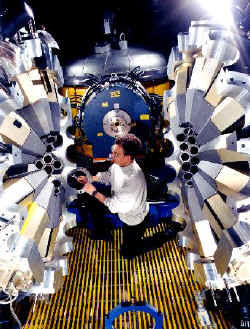A New Spin on Nobelium

According to classical physics, elements with more than 100 protons in their nuclei should fly apart almost as soon as they are created, because of the tremendous electric repulsion between the protons. But surprisingly, they are relatively stable. Physicists have built up quantum mechanical theories to explain the observation, and now there is some experimental verification of these theories in the 18 January PRL. A collaboration of physicists has discovered that the nucleus of the heavy element nobelium is deformed like a football by the same amount that the theories predict. The experiments have also revealed some new information: Even in states of extremely high spin this delicately bound nucleus remains intact and does not fly apart.
Protons and neutrons in a nucleus organize themselves into energy levels, just as electrons do in an atom, and nuclei with fully filled energy levels are remarkably stable. Lead, with its 82 protons and 126 neutrons, is the heaviest known element with such a stable, “magic number” of nucleons. Although theorists find it difficult to calculate the next magic number, they had long expected to find a stable element with at least 114 protons, surrounded in the periodic table by unstable elements. Instead, experiments began turning up a range of nuclei with up to 112 protons that seemed to be protected against spontaneously breaking up, so theorists went back to the drawing board to find out why. The key to this “nonmagic” stability seemed to be a deformation of the nucleus into a football shape.
Teng Lek Khoo and Peter Reiter of the Argonne National Laboratory in Illinois and a number of collaborators set out to look for signs of this deformation in nobelium, which has 102 protons and 152 neutrons. The deformation, they knew, would show up in the spectrum of gamma rays emitted by the nucleus as it decayed from one rotational state to another. The challenge was twofold: to make enough nobelium, and to weed out the gamma rays released by the nobelium from a background that was about 10,000 times stronger. “We literally had to fish out a needle from a haystack,” says Khoo. What made the experiment possible, he adds, was the combination of Gammasphere–a new array of 110 germanium detectors–with an Argonne machine called the Fragment Mass Analyzer (FMA).
To make nobelium, the ATLAS accelerator at Argonne smashed calcium nuclei into lead targets. The products of the collision then flew through the FMA, which recognized the nobelium nuclei by their masses and flight times. To be absolutely certain they were observing the right nuclei, the team used a silicon detector to spot nobelium’s distinctive signature of alpha particles as it decays. Correlating the arrival times of those alphas with the times of gamma ray detections, the researchers could isolate the nobelium gamma signal from the large background. The difference in energy of gamma rays coming from different rotational states confirmed that the amount of deformation of the nucleus was close to what was predicted by theories. The team also used the data to deduce the spin of the nuclei and found values as high as 14 units of angular momentum.
Witold Nazarewicz of the University of Tennessee in Knoxville sees multiple rewards for nuclear physicists from these experiments. “They confirm the models,” he says, and they give theorists an incentive to calculate the stability of these nuclei at high spins. “Before, there was no strong experimental motivation to do that.” He also believes that these experiments might lead to ways to fabricate and study truly heavy elements–those with up to 126 protons–to test the theories that predict which elements are magic.
–Meher Antia
Meher Antia is a freelance science writer.


